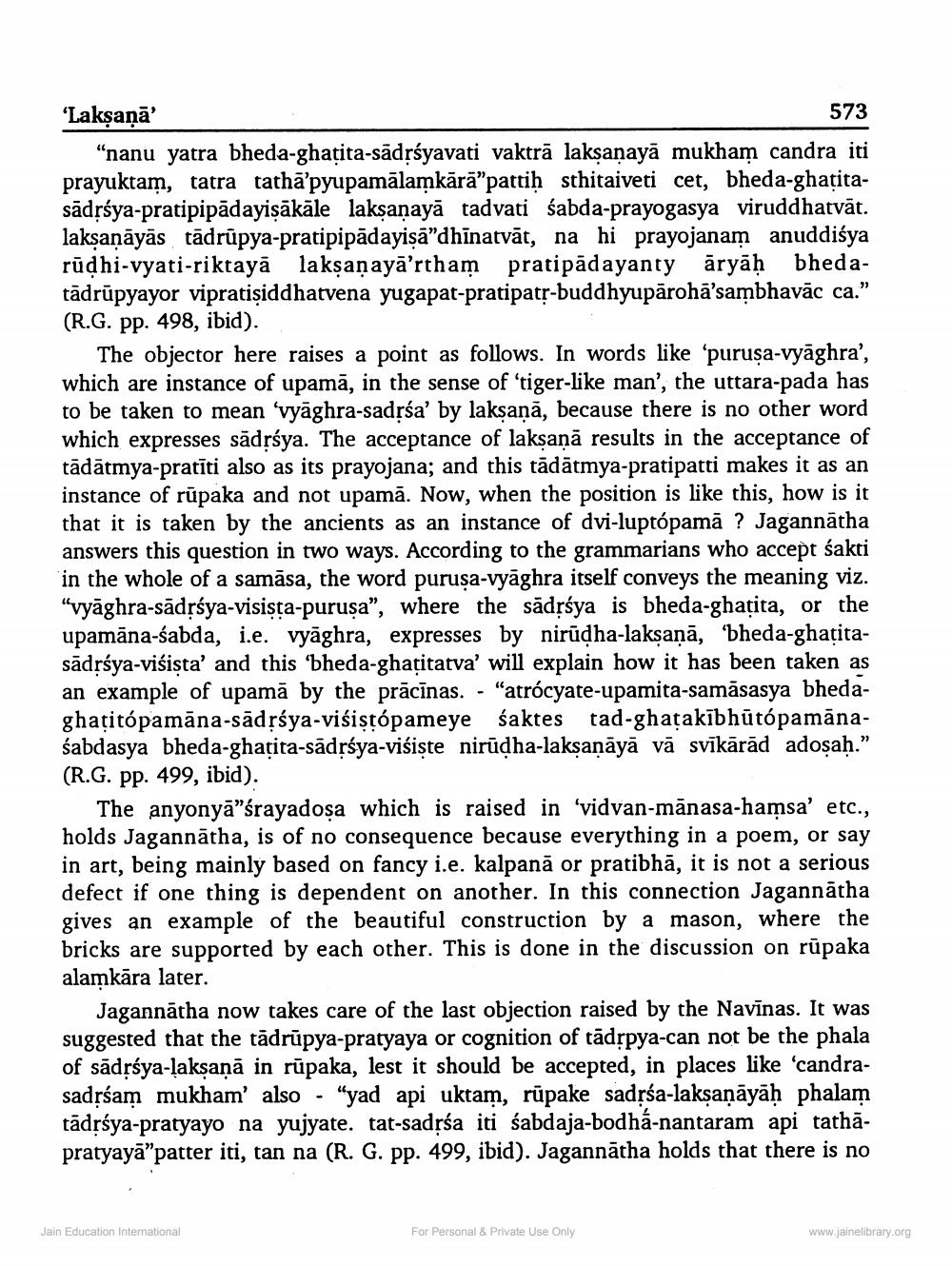________________
‘Lakşaņā
573 “nanu yatra bheda-ghațita-sādrśyavati vaktrā laksanayā mukham candra iti prayuktam, tatra tathā’pyupamālamkārā”pattiḥ sthitaiveti cet, bheda-ghatitasādrśya-pratipipādayişākāle lakṣaṇayā tadvatisabda-prayogasya viruddhatvāt. laksanāyās tādrūpya-pratipipādayişā”dhīnatvāt, na hi prayojanam anuddiśya rūdhi-vyati-riktayā laksaņayā'rtham pratipadayanty āryāḥ bhedatādrūpyayor vipratisiddhatvena yugapat-pratipatr-buddhyupārohā'sambhavāc ca." (R.G. pp. 498, ibid).
The objector here raises a point as follows. In words like 'purusa-vyāghra', which are instance of upamā, in the sense of 'tiger-like man', the uttara-pada has to be taken to mean 'vyāghra-sadrśa' by laksaņā, because there is no other word which expresses sādrśya. The acceptance of laksaņā results in the acceptance of tādātmya-pratīti also as its prayojana; and this tādātmya-pratipatti makes it as an instance of rūpaka and not upamā. Now, when the position is like this, how is it that it is taken by the ancients as an instance of dvi-luptópamā ? Jagannātha answers this question in two ways. According to the grammarians who accept sakti in the whole of a samāsa, the word purusa-vyāghra itself conveys the meaning viz. "vyāghra-sādrśya-visista-purusa”, where the sādņśya is bheda-ghasita, or the upamāna-sabda, i.e. vyāghra, expresses by nirūdha-lakṣaṇā, bheda-ghațitasādrśya-višişta' and this 'bheda-ghațitatva' will explain how it has been taken as an example of upamā by the prācīnas. - "atrocyate-upamita-samāsasya bhedaghatitopamāna-sādssya-viśistópameye śaktes tad-ghatakībhūtópamānaśabdasya bheda-ghațita-sādrśya-višiște nirūdha-lakṣaṇāyā vā svīkārād adoṣaḥ.” (R.G. pp. 499, ibid).
The anyonya"śrayadosa which is raised in 'vidvan-mānasa-hamsa' etc., holds Jagannātha, is of no consequence because everything in a poem, or say in art, being mainly based on fancy i.e. kalpanā or pratibhā, it is not a serious defect if one thing is dependent on another. In this connection Jagannātha gives an example of the beautiful construction by a mason, where the bricks are supported by each other. This is done in the discussion on rūpaka alamkāra later.
Jagannātha now takes care of the last objection raised by the Navīnas. It was suggested that the tādrūpya-pratyaya or cognition of tādrpya-can not be the phala of sādrśya-laksaņā in rūpaka, lest it should be accepted, in places like 'candrasadrśam mukham' also - "yad api uktam, rūpake sadrśa-laksaņāyāḥ phalam tādrśya-pratyayo na yujyate. tat-sadrśa iti śabdaja-bodha-nantaram api tathāpratyayā"patter iti, tan na (R. G. pp. 499, ibid). Jagannātha holds that there is no
Jain Education International
For Personal & Private Use Only
www.jainelibrary.org




